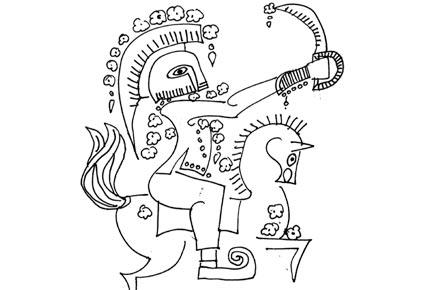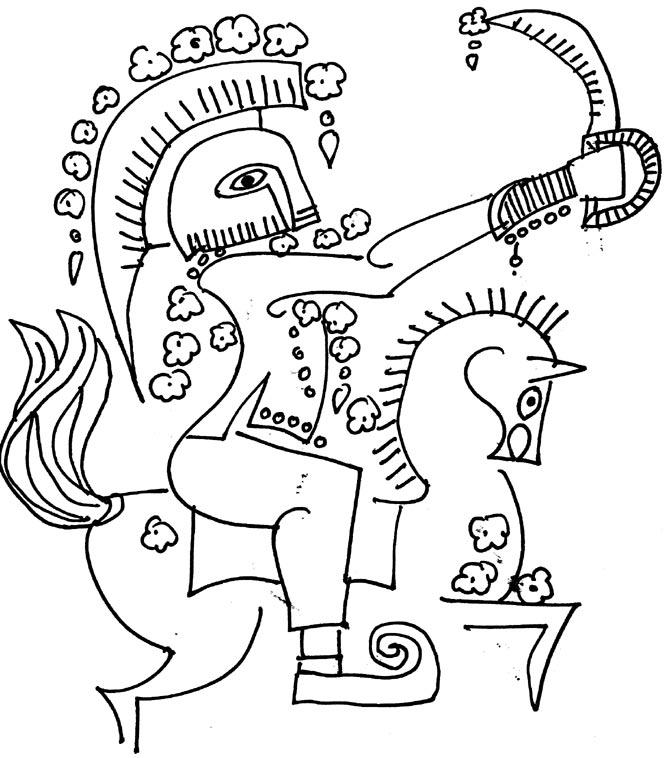No, this is not yet another article on much admired filmmakers who confuse Bollywood with European art house cinema, Mumbai with Chicago, cannot take any criticism, and declare they want to sulk in grand exotic locations, when the market does not indulge them, to that favourite background score of drama queens, 'I will survive!'

Illustration/Devdutt Pattanaik
 No, this is not yet another article on much admired filmmakers who confuse Bollywood with European art house cinema, Mumbai with Chicago, cannot take any criticism, and declare they want to sulk in grand exotic locations, when the market does not indulge them, to that favourite background score of drama queens, 'I will survive!'
No, this is not yet another article on much admired filmmakers who confuse Bollywood with European art house cinema, Mumbai with Chicago, cannot take any criticism, and declare they want to sulk in grand exotic locations, when the market does not indulge them, to that favourite background score of drama queens, 'I will survive!'
ADVERTISEMENT
This is about other gladiators, beyond the wells of Bollywood, Delhi, India Inc and cricket: young Dalit grooms who wish to go to their brides' house on a mare, and have to wear helmets, as many of them are pelted with stones by some upper caste people, both men and women, for daring to do so.
But don't people tell us that this practice is Hindu? Or is it just North Indian upper caste Hindu? Is it restricted to a particular community? But if Tamil Brahmins, or Reddys of Andhra, can include that very North Indian ritual of 'Sangeet', made famous by Bollywood movies and TV Serials, to add joy to their wedding ceremonies, in the Age of Remix, why can't Dalit youths anywhere travel on mares? Why does their refusal to walk, and determination to ride, threaten so many people?
The stories in newspapers are chilling. Stones being thrown. Roads being blocked. Water being poisoned. But the boys sit firm on those mares. Slowly, the old oppressive structures will give way. They won't run away. They may typically perhaps be accused of being part of a political conspiracy to rouse the rabble to undermine good work of our beloved leaders. But they will challenge the system from within, silent determined low-grade sustainable transformations, not massive revolutions, with the beating of chests in media glare.
Illustration/Devdutt Pattanaik
Caste is an Indian reality. I remember how my surname was constantly asked in a village near Mumbai to determine if tea should be served to me in a metal cup or a glass cup. I also remember this short film titled In the City that won the 2013 Mumbai Film Festival award that showed a Dalit youth, who discovers that no one cares about his caste when he comes to the city as he is touched by more people in a Mumbai local train than he has ever been touched in his entire life in the village. Change eventually happens often in the most surprising ways. Of course, cities come with their own set of new discriminations.
There will always be caste deniers, caste apologists, even caste defenders: those who see every criticism of India as mockery designed to embarrass our NRI cousins. Then there are those who attack every non-Dalit sympathiser of Dalit causes, especially those who do not toe their lines, rather contemptuously and cynically as 'savarna' wolves in sheep clothing.
I guess, in anger, even supporters and sympathisers start appearing as oppressors. And sometimes even earnest supporters fail to realise that their support is in fact a kind of patronising exploitation. We deny. We get out swords, stones and helmets. Thus we construct lions to fight in the arena called life.
We are all gladiators in some way, facing some discrimination or the other, wearing helmets to protect us from the stones, unaware that we may casting stones on someone else. There is no audience out there, no king who enjoys the blood sport. The richest and the powerful also feel they have to fight oppression and discrimination for being rich and famous and beautiful. All fight to survive, to demand dignity. All of us make embarrassing mistakes. All of us have days when we would like to indulge ourselves as victims of the system and martyrs to the cause. Some of us also need to make a spectacle of it.
The author writes and lectures on relevance of mythology in modern times, and can be reached at devdutt@devdutt.com
 Subscribe today by clicking the link and stay updated with the latest news!" Click here!
Subscribe today by clicking the link and stay updated with the latest news!" Click here!







